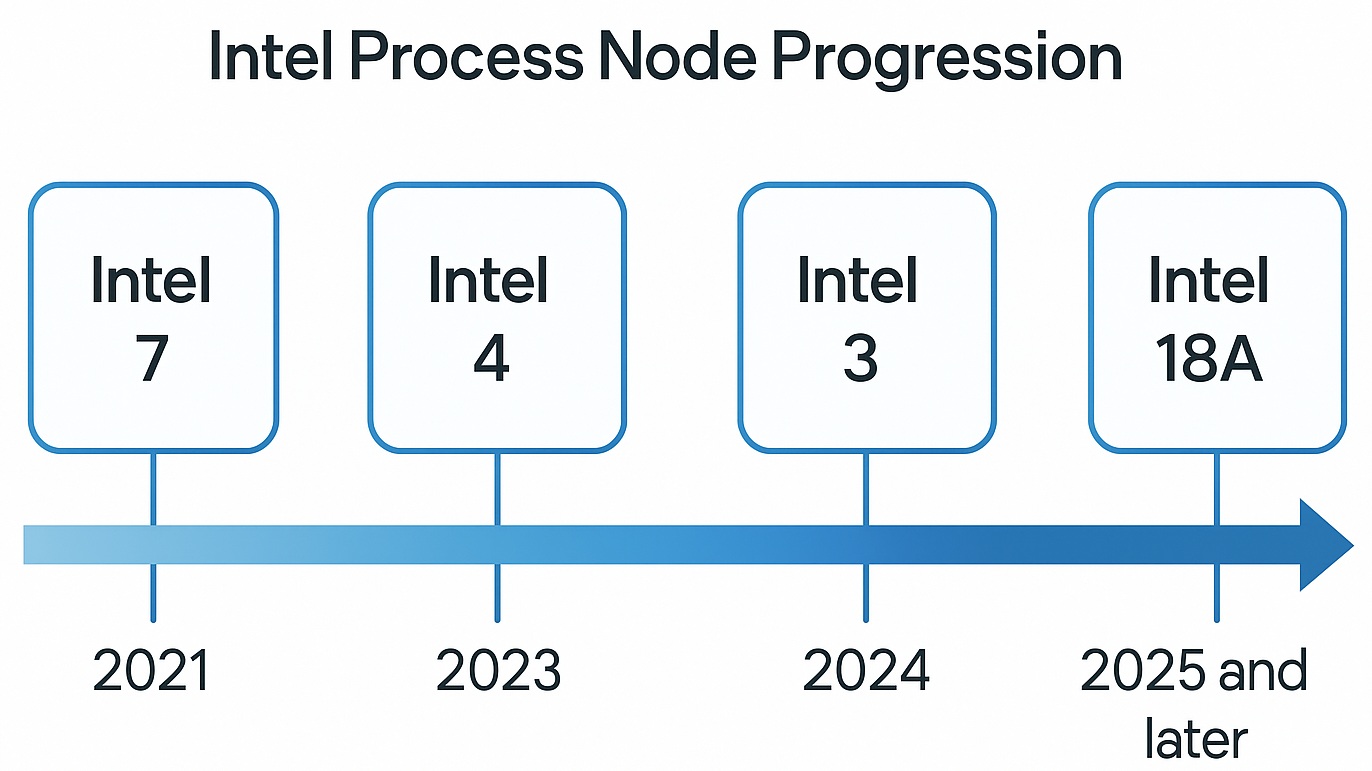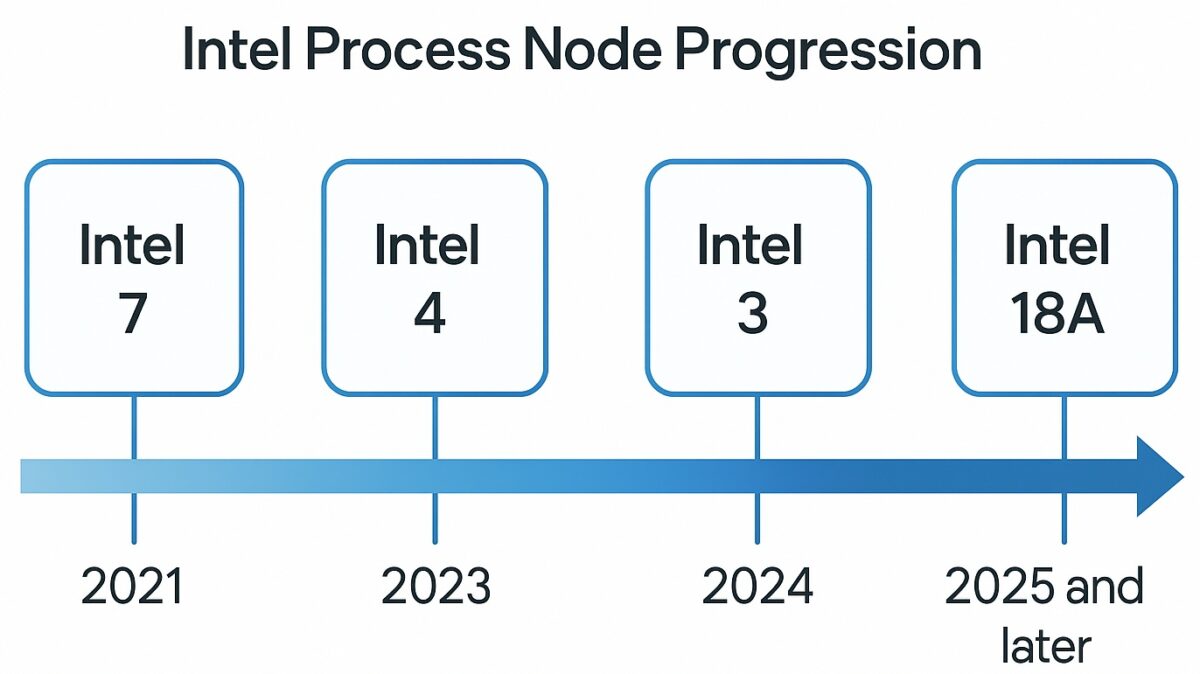Overview
| Feature | Intel 3 | Intel 18A |
|---|---|---|
| Node Class | Enhanced 7nm (refinement of Intel 4) | 1.8nm-class full-node leap |
| Transistor Type | FinFET | RibbonFET (GAAFET) |
| Power Delivery | Front-side power only | Backside Power Delivery (PowerVia) |
| EUV Use | Partial (select layers) | Extensive EUV, reduced multi-patterning |
| PPA Target | Modest vs. Intel 4 | +10–15% perf, –25–30% power vs. Intel 3 |
| HVM Timeline | 2023–2024 | 2025+ (internal first, external foundry late) |
Technology and Transistor Architecture
Intel 3
-
Derivative of Intel 4 (7nm-class), offering:
-
Slight scaling improvements
-
Performance-per-watt gains
-
Refined FinFET transistors
-
-
Targets Intel internal products and select foundry customers
-
Still uses traditional front-side power delivery
Intel 18A
-
A true next-generation node
-
Introduces:
-
RibbonFET (Intel’s implementation of Gate-All-Around FETs)
-
PowerVia (first backside power delivery on a leading-edge process)
-
-
Provides major advantages in:
-
Electrostatics
-
Area efficiency
-
Signal integrity and routing density
-
Performance, Power & Density (PPA)
| Metric | Intel 3 | Intel 18A |
|---|---|---|
| Performance | ~+18% over Intel 4 | +10–15% over Intel 3 |
| Power | ~–18% power vs Intel 4 | ~–25–30% vs Intel 3 (at same performance) |
| Density | Incremental over Intel 4 | Full-node gain: much smaller standard cell area |
| SRAM Scaling | ~10–15% | Optimized bitcells for GAA era |
PowerVia vs. Front-side Power
| Feature | Intel 3 | Intel 18A |
|---|---|---|
| Power Delivery | Front-side (traditional) | Backside (PowerVia) |
| Routing Area | Signal + power metal layers | Signal-only (cleaner routing) |
| Benefits | Mature & lower risk | Better power integrity, reduced congestion |
| Design Tools | Standard EDA flow | Requires PowerVia-aware flow (enabled via Intel Foundry) |
Design Ecosystem
| Element | Intel 3 | Intel 18A |
|---|---|---|
| EDA Enablement | Synopsys, Cadence, Siemens, Ansys (DFX tools) | Same partners + enhanced tools for PowerVia/GAA |
| IP Ecosystem | Arm (limited cores), Intel IP | Arm Cortex, PCIe Gen5/6, DDR5/LPDDR5X, AI IP |
| Packaging Options | EMIB, FCBGA | EMIB, Foveros Direct, UCIe (chiplets) |
Timeline and Adoption
| Year | Intel 3 | Intel 18A |
|---|---|---|
| 2022 | Risk production | RibbonFET & PowerVia test chips shown |
| 2023 | Volume ramp for Sierra Forest, Granite Rapids | Pre-production of test SoCs |
| 2024 | HVM in Intel servers | Internal SoCs (e.g., Clearwater Forest) |
| 2025 | Select foundry customer ramp | Commercial availability via Intel Foundry Services (IFS) |
Strategic Significance
-
Intel 3 is the final FinFET node, extending the life of mature tools and enabling continuity before the GAA transition.
-
Intel 18A is the cornerstone of Intel’s IDM 2.0 and IFS strategy, showcasing both design leadership and foundry competitiveness.
-
Intel 18A is designed to be foundry-first, with full support for external fabless customers and chiplet ecosystems (UCIe).
Looking Ahead
| Intel Node | Transistor | Power Delivery | High-NA EUV |
|---|---|---|---|
| Intel 3 | FinFET | Front-side | No |
| Intel 18A | RibbonFET | PowerVia | No (yet) |
| Post-18A (14A or 10A?) | RibbonFET+, Forksheet | TBD | High-NA possible |
Summary Table
| Attribute | Intel 3 | Intel 18A |
|---|---|---|
| Node Class | 7nm-class | 1.8nm-class (advanced) |
| Transistor | FinFET | RibbonFET (GAAFET) |
| Backside Power | ❌ | ✅ PowerVia |
| PPA Gain (vs prior) | ~+18% perf / –18% power | +10–15% perf / –25–30% power |
| Availability | 2023–2024 | 2025 (internal), 2025+ (external) |














Jensen Huang Drops Donald Trump Truth Bomb on Joe Rogan Podcast